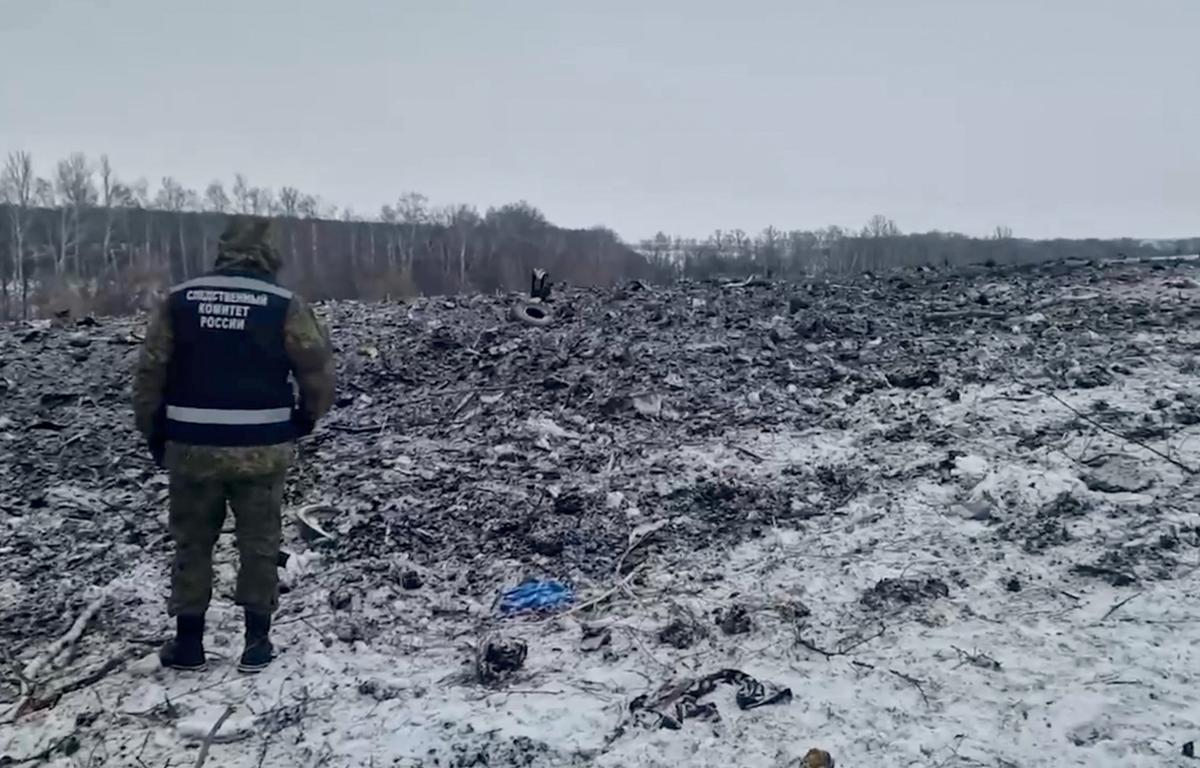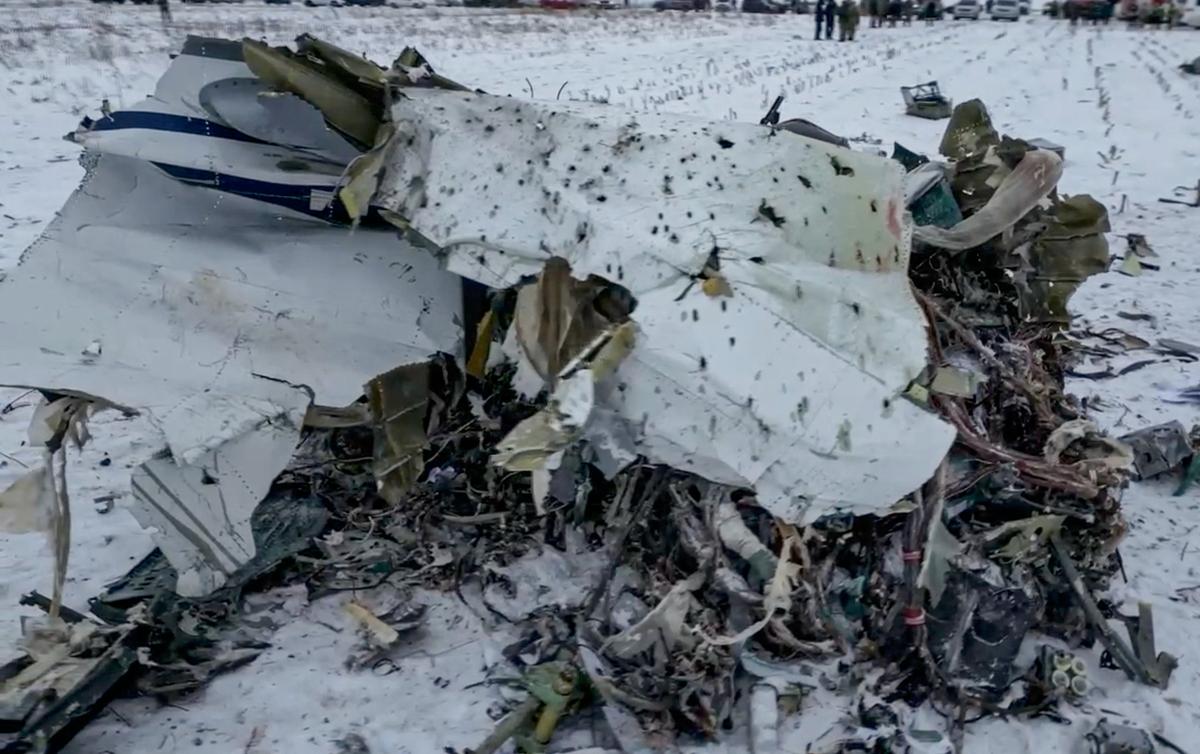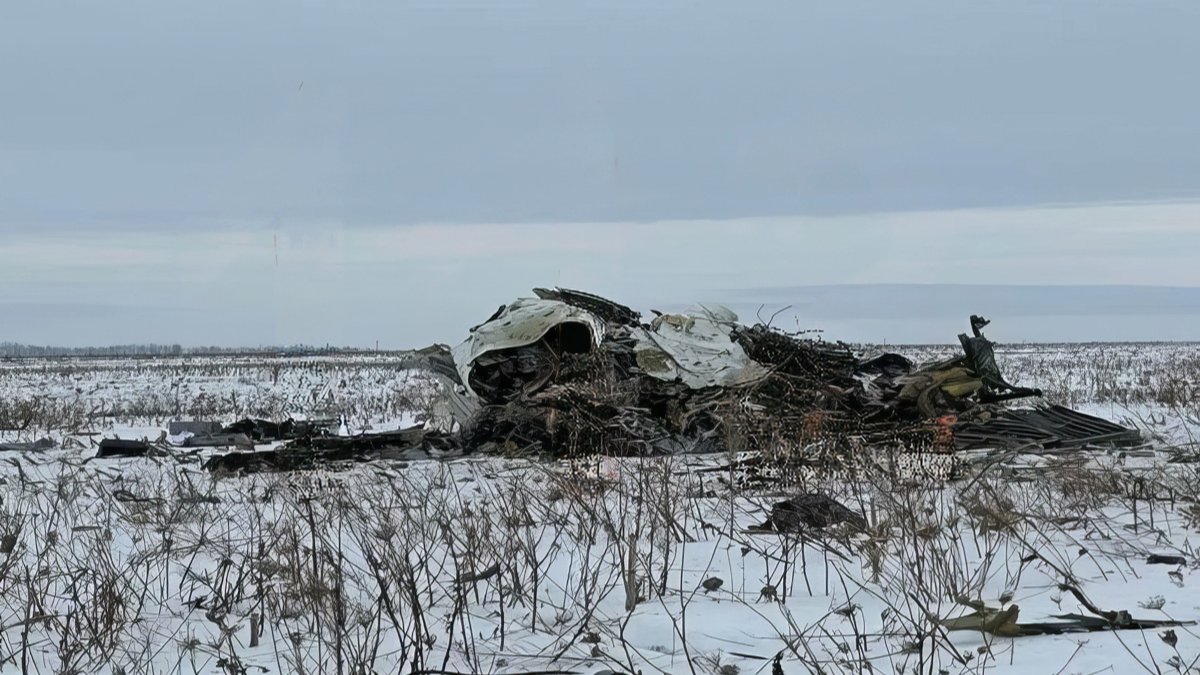The apparent downing of a Russian Il-76 transport plane over Russia’s Belgorod region on Wednesday is likely to remain a battleground for competing narratives for some time, as officials and experts continue to push differing interpretations of the events in the absence of almost any confirmed facts about the incident.
Russian officials
In the immediate aftermath of the crash, Russia’s Ministry of Defence claimed that Ukraine had committed a “terrorist act” by shooting down the plane, which it said had been transporting 65 Ukrainian POWs to a prisoner exchange scheduled to take place later the same day. The ministry claimed that the plane was shot down from around Liptsy, a village in Ukraine’s Kharkiv region, and that the Ukrainian authorities “knew perfectly well” that the plane was carrying Ukrainian POWs.
Following the Defence Ministry’s statement, Russian officials and lawmakers hurried to support the army’s claims, with head of the State Duma Defence Committee Andrey Kartapolov suggesting just hours after the crash that the plane was shot down with a Patriot missile supplied to Ukraine by the West.
Former Russian President Dmitry Medvedev, notorious for his hawkish views, accused the “neo-Nazis” in Kyiv of shooting down the plane. Duma speaker Vyacheslav Volodin doubled down on the hysteria, accusing the Ukrainian “Nazi regime” and the Western leaders who “nursed it” of downing the plane.
Kremlin spokesman Dmitry Peskov called the downing of the plane a “monstrous act” on Thursday, agreeing to an international investigation of the crash “only as an investigation of the crimes of the Kiev regime”.
Russian President Vladimir Putin stayed silent in the immediate aftermath of the crash, finally blaming Ukraine for downing the Il-76 “with American or French missile systems” during a meeting with Russian soldiers on Friday. Putin repeated the Russian claim that Ukraine had been aware of the plane’s route and cargo in advance.

Footage from the crash site provided by the Russian Investigative Committee on Thursday.
Ukrainian officials
While Russian officials were quick to capitalise on the alleged deaths of Ukrainian POWs, Ukraine has been more cautious in its official statements. Ukraine’s Main Directorate of Intelligence issued a statement on Wednesday in which it did not directly confirm or deny Ukraine’s role in the plane’s downing, saying that there was a lack of “reliable and comprehensive information about who was on board the plane and in what number”. The statement contradicted the Russian Defence Ministry’s claim that Ukraine had been made aware of the plane’s route in advance, accusing Russia of “endangering the lives and safety of prisoners” in a deliberate attempt to discredit Ukraine internationally.
The Ukrainian General Staff did not directly acknowledge the plane crash in its official statement made six hours after the event, either. It did say that Ukraine was “closely monitoring the logistics of missile supply, especially with the use of military transport aircraft”.
The Ukrainian Commissioner for Human Rights, Dmytro Lubinets, the person responsible for prisoner exchanges, posted a vague acknowledgement of the plane crash. He neither confirmed nor denied that a prisoner exchange had been due to take place the same day, merely asking the media to not jump to premature conclusions or spread false information.
Ukrainian President Volodymyr Zelensky came out with an official statement late on Wednesday, calling for an international investigation into the crash and accusing Russia of “playing with Ukrainian lives”.
Expert and media comments
The Ukrainian open source intelligence Telegram channel Pandora’s Box reported several hours after the crash that the Il-74 had in fact taken off from Belgorod and was headed towards central Russia, claiming to have acquired the plane’s flight number. The post also claimed that the plane had been spotted flying over the Middle East the same day, speculating that it could have been used for delivering weapons, a theory that aligns with the initial report on the plane crash published by Ukrainian newspaper Ukrainska Pravda, which cited a Ukrainian military source saying that the plane had been carrying S-300 missiles.

Wreckage of the plane. Photo: Russian Investigative Committee
Russian independent media outlet Verstka disputed the information about the plane’s tail number, on the basis that the flight’s radar data did not match up, and that the plane in question was spotted near Cyprus just an hour before the crash, which would have been insufficient time for it to reach Belgorod.
After Russian propagandist Margarita Simonyan posted a list she said contained the names of the Ukrainian POWs aboard the flight, independent media outlets, including Novaya Gazeta Europe and IStories, verified the names belonged to existing Ukrainian prisoners, but also found that some of the men on the list had been exchanged as early as 3 January.
IStories also questioned the veracity of the death toll on the basis that no bodies were visible in photographs of the crash site. It also voiced its doubts that the plane was transporting prisoners as it said the plane was travelling away from the Ukrainian border at the time of the crash.
Theories predicated on discrepancies between the plane’s supposed destination and its direction of travel at the time of its downing are some of the more easily debunked, as an aircraft can be required to adjust course for a number of reasons before coming into land.
Ukrainian Telegram channel Joker, rumoured to have sources in the Zelensky administration, argued that the Russian military downed one of its own aircraft on purpose, claiming the plane was shot down shortly after takeoff, rather than just before landing as was widely reported.
While initial commenters disputed the idea that Russia would use a military transport plane for the transfer of POWs, Ruslan Leviev, founder of the Conflict Intelligence Team military think-tank, confirmed that Il-76 planes are in fact used for that purpose with a former Ukrainian prisoner of war. Speaking to German media outlet Bild, Leviev said that both Russia and Ukraine possessed technical capability to shoot down the plane, adding that video footage of the crash indicated that an anti-aircraft missile system had been used.
Leviev did not rule out that an independent open source intelligence investigation into the crash would be possible once more information was available — most importantly, once the flight number has been confirmed, meaning that it can be used to pin down the exact route the aircraft used on 24 January.
Join us in rebuilding Novaya Gazeta Europe
The Russian government has banned independent media. We were forced to leave our country in order to keep doing our job, telling our readers about what is going on Russia, Ukraine and Europe.
We will continue fighting against warfare and dictatorship. We believe that freedom of speech is the most efficient antidote against tyranny. Support us financially to help us fight for peace and freedom.
By clicking the Support button, you agree to the processing of your personal data.
To cancel a regular donation, please write to [email protected]

